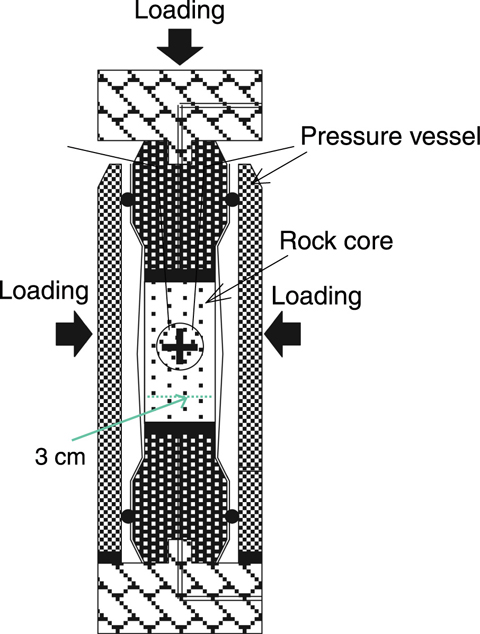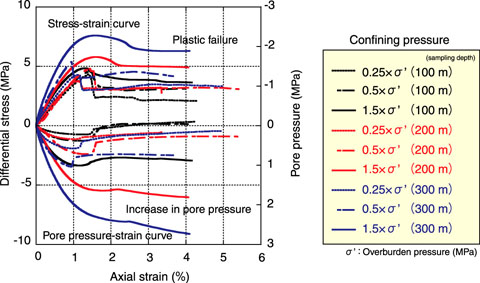
Fig.2-18 System of laboratory testing

Fig.2-19 An example of laboratory test results
Several tunnels will be required in a repository of high-level radioactive waste (HLW) due to transportation of the HLW and engineered barriers, and ventilation openings. When tunnels deep underground are excavated, stress in the surrounding rock mass is increased due to stress redistribution. Deformation and failure around tunnels are then estimated to occurred. Therefore, it is necessary to understand rock mass failure and deformation for excavation and planning of a repository site.
Compared with other countries, the sedimentation period of sedimentary rock in Japan is so recent that their mechanical features are porous and weak. Therefore, it can be anticipated that microstructural failure and changes in hydraulic parameters such as pore pressure and hydraulic conductivity with stress variation will occur. Accordingly, we carried out rock mechanical testing such as tri-axial compression tests using rock cores taken from deep boreholes in the Horonobe URL Project to clarify the deformation and failure properties of sedimentary rocks. In addition, the relationship between mechanical behavior and microstructure was investigated via microscopic observations.
Examples of laboratory tests are described in Fig.2-18 and Fig.2-19. After rock cores were sampled, they were set in a pressure vessel and crushed under a load. Because the pore pressure and volumetric strain in the rock core during the pressure loading were recorded, volumetric dilatancy and pore pressure behavior could be evaluated. Fig.2-19 shows stress-strain curves for diatomaceous mudstone from the Koetoi formation. The Koetoi formation is composed of diatom including numerous tiny pores, and it possesses features of porosity and low permeability. According to the test results, the stress-strain shape switched from strain softening to ductile behavior with an increase in confining pressure. In addition, a large confining pressure led to an increase in pore pressure. Increasing pore pressure during shearing can be expected to lead to microstructural failure and shrinkage with an increase in confining pressure.
Mine-by experiments are being conducted in the Horonobe URL Project, and technical insights taken from the laboratory tests were used for interpretation of mine-by experiments and rock mechanical modeling.